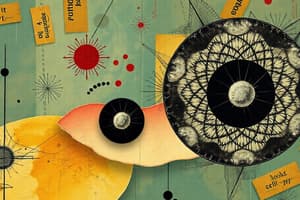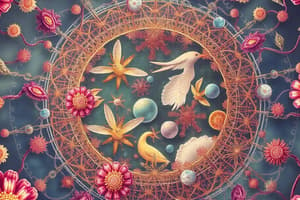Podcast
Questions and Answers
What is the primary role of the mitochondria in a eukaryotic cell?
What is the primary role of the mitochondria in a eukaryotic cell?
- Cell division
- ATP production (correct)
- Protein synthesis
- Photosynthesis
Which of the following best describes the process of meiosis?
Which of the following best describes the process of meiosis?
- It is a continuous process without distinct phases.
- It involves two rounds of division resulting in genetically identical cells.
- It occurs only in prokaryotic organisms.
- It produces gametes with half the chromosome number of the parent cell. (correct)
Which type of transport mechanism requires energy input?
Which type of transport mechanism requires energy input?
- Simple diffusion
- Active transport (correct)
- Facilitated diffusion
- Osmosis
During which phase of mitosis do the sister chromatids separate and move toward opposite poles?
During which phase of mitosis do the sister chromatids separate and move toward opposite poles?
What role does the Golgi apparatus play in a cell?
What role does the Golgi apparatus play in a cell?
What is the function of ribosomes in a cell?
What is the function of ribosomes in a cell?
What type of cellular signaling occurs when a cell communicates with itself?
What type of cellular signaling occurs when a cell communicates with itself?
Which of the following statements is true regarding prokaryotic cells?
Which of the following statements is true regarding prokaryotic cells?
What characterizes prokaryotic cells compared to eukaryotic cells?
What characterizes prokaryotic cells compared to eukaryotic cells?
Which organelle is primarily responsible for modifying and packaging proteins?
Which organelle is primarily responsible for modifying and packaging proteins?
Which statement about the cell membrane is TRUE?
Which statement about the cell membrane is TRUE?
In which stage of cellular respiration is ATP synthesized in the greatest quantity?
In which stage of cellular respiration is ATP synthesized in the greatest quantity?
Meiosis results in the production of what type of cells?
Meiosis results in the production of what type of cells?
Which of the following statements best describes cellular respiration?
Which of the following statements best describes cellular respiration?
During which stage of the cell cycle do cells primarily grow and prepare for division?
During which stage of the cell cycle do cells primarily grow and prepare for division?
What is the main function of lysosomes within a cell?
What is the main function of lysosomes within a cell?
Flashcards are hidden until you start studying
Study Notes
Cell Biology
1. Basic Unit of Life
- The cell is the fundamental unit of life.
- All living organisms are composed of one or more cells.
2. Types of Cells
- Prokaryotic Cells
- Lack a nucleus and membrane-bound organelles.
- Examples: Bacteria and Archaea.
- Eukaryotic Cells
- Have a nucleus and membrane-bound organelles.
- Examples: Animal cells, Plant cells, Fungal cells.
3. Cell Structure
- Cell Membrane
- Phospholipid bilayer that controls the movement of substances in and out of the cell.
- Nucleus
- Contains genetic material (DNA).
- Controls cell activities and regulates gene expression.
- Cytoplasm
- Gel-like substance where cellular components are suspended.
- Organelles
- Mitochondria – Powerhouse of the cell; site of ATP production.
- Ribosomes – Protein synthesis; can be free-floating or attached to the endoplasmic reticulum.
- Endoplasmic Reticulum (ER)
- Rough ER – Studded with ribosomes; involved in protein synthesis and processing.
- Smooth ER – No ribosomes; involved in lipid synthesis and detoxification.
- Golgi Apparatus – Modifies, sorts, and packages proteins and lipids for secretion or use within the cell.
- Lysosomes – Contain enzymes for digestion and waste removal.
- Chloroplasts (in plant cells) – Site of photosynthesis, converts solar energy into chemical energy.
4. Cell Division
- Mitosis
- Process of cell division that results in two genetically identical daughter cells.
- Phases: Prophase, Metaphase, Anaphase, Telophase.
- Meiosis
- Specialized form of cell division that produces gametes (sperm and egg).
- Results in four genetically diverse daughter cells.
5. Cell Transport Mechanisms
- Passive Transport
- Movement of substances across the cell membrane without energy input.
- Types: Diffusion, Osmosis, Facilitated diffusion.
- Active Transport
- Movement of substances against a concentration gradient, requiring energy (ATP).
- Example: Sodium-potassium pump.
6. Cell Signaling
- Cells communicate through signaling molecules (hormones, neurotransmitters).
- Types of signaling:
- Autocrine – Cell signals itself.
- Paracrine – Cell signals nearby cells.
- Endocrine – Signals through the bloodstream to distant cells.
7. Cell Cycle Regulation
- Controlled by checkpoints to ensure proper division and function.
- Key proteins include cyclins and cyclin-dependent kinases (CDKs).
8. Apoptosis
- Programmed cell death, crucial for development and maintenance of healthy tissues.
- Involves a series of biochemical events leading to cell fragmentation.
9. Cellular Metabolism
- All chemical reactions within a cell that maintain life.
- Includes catabolism (breaking down molecules for energy) and anabolism (building up molecules).
Basic Unit of Life
- Cells are the fundamental unit of life and form the building blocks of all living organisms.
Types of Cells
- Prokaryotic Cells
- Lack a nucleus and membrane-bound organelles.
- Examples include Bacteria and Archaea.
- Eukaryotic Cells
- Have a nucleus and membrane-bound organelles.
- Examples include Animal cells, Plant cells, and Fungal cells.
Cell Structure
- Cell Membrane
- Composed of a phospholipid bilayer, it regulates the entry and exit of substances.
- Nucleus
- Houses genetic material (DNA) and controls cellular functions and gene expression.
- Cytoplasm
- A gel-like medium that suspends cellular components.
- Organelles
- Mitochondria: Known as the powerhouse of the cell; site of ATP production.
- Ribosomes: Sites of protein synthesis; can be free or attached to the endoplasmic reticulum.
- Endoplasmic Reticulum (ER)
- Rough ER: Studded with ribosomes; involved in protein synthesis and processing.
- Smooth ER: Lacks ribosomes; involved in lipid synthesis and detoxification.
- Golgi Apparatus: Modifies, sorts, and packages proteins and lipids for secretion or intracellular use.
- Lysosomes: Contain enzymes used for digestion and waste removal.
- Chloroplasts: Found in plant cells; responsible for photosynthesis and converting solar energy to chemical energy.
Cell Division
- Mitosis
- Leads to two genetically identical daughter cells.
- Involves phases: Prophase, Metaphase, Anaphase, and Telophase.
- Meiosis
- Produces gametes (sperm and egg) resulting in four genetically diverse daughter cells.
Cell Transport Mechanisms
- Passive Transport
- Involves the movement of substances across the membrane without energy; includes diffusion, osmosis, and facilitated diffusion.
- Active Transport
- Requires energy (ATP) to move substances against a concentration gradient, exemplified by the sodium-potassium pump.
Cell Signaling
- Cells use signaling molecules such as hormones and neurotransmitters to communicate.
- Types of signaling include:
- Autocrine: Cell signals itself.
- Paracrine: Cell signals neighboring cells.
- Endocrine: Signals are transported through the bloodstream to distant cells.
Cell Cycle Regulation
- Regulated by checkpoints to guarantee proper division and function.
- Key regulatory proteins include cyclins and cyclin-dependent kinases (CDKs).
Apoptosis
- Defined as programmed cell death, essential for normal development and tissue maintenance.
- Involves a sequence of biochemical events leading to cell disintegration.
Cellular Metabolism
- Encompasses all chemical reactions that sustain life within a cell.
- Comprises two main processes: catabolism (energy-extracting breakdown of molecules) and anabolism (constructing molecules from smaller units).
Basic Cell Structure
- Cell Theory asserts that all living organisms consist of cells, which are the fundamental unit of life, and that all cells originate from other existing cells.
- Prokaryotic Cells: Characterized by the absence of a nucleus and membrane-bound organelles; examples include Bacteria and Archaea.
- Eukaryotic Cells: Contain a nucleus and organelles; examples include Animal cells, Plant cells, Fungi, and Protists.
Organelles and Their Functions
- Nucleus: Stores genetic material (DNA) and oversees cell function and gene expression.
- Mitochondria: Known as the powerhouses of the cell, responsible for ATP production via cellular respiration.
- Ribosomes: Essential for protein synthesis; can be free in the cytoplasm or associated with the endoplasmic reticulum.
- Endoplasmic Reticulum (ER):
- Rough ER: Contains ribosomes, synthesizes proteins.
- Smooth ER: Lacks ribosomes, involved in lipid synthesis and detoxification.
- Golgi Apparatus: Processes, sorts, and packages proteins and lipids for cellular use or secretion.
- Lysosomes: House digestive enzymes that break down waste and cellular debris.
- Chloroplasts (exclusive to plant cells): Conduct photosynthesis, transforming solar energy into glucose.
- Cell Membrane: A semi-permeable barrier composed of a phospholipid bilayer with proteins; regulates entry and exit of substances.
Cell Division
- Mitosis: A type of cell division resulting in two identical daughter cells, comprising stages: Prophase, Metaphase, Anaphase, Telophase, and Cytokinesis.
- Meiosis: A specialized cell division producing gametes (sperm and eggs), involving two rounds of division leading to four genetically unique daughter cells.
Cellular Processes
- Cellular Respiration: Converts glucose and oxygen into ATP, carbon dioxide, and water, progressing through Glycolysis, the Krebs cycle, and the Electron transport chain.
- Photosynthesis: Involves converting sunlight, carbon dioxide, and water into glucose and oxygen through Light-dependent reactions and the Calvin cycle.
- Cell Signaling: Governs cellular activities and coordination through signaling molecules like hormones and neurotransmitters interacting with receptors.
Key Concepts
- Cell Membrane Dynamics: The fluid mosaic model explains the structure of the cell membrane, which facilitates active and passive transport mechanisms for substance regulation.
- Endocytosis and Exocytosis:
- Endocytosis is the mechanism for importing substances, while Exocytosis exports materials from the cell.
- Stem Cells: Undifferentiated cells capable of developing into various cell types; include embryonic stem cells (pluripotent) and adult stem cells (multipotent).
- Apoptosis: A regulated process of programmed cell death essential for maintaining health and proper development of organisms.
Studying That Suits You
Use AI to generate personalized quizzes and flashcards to suit your learning preferences.




